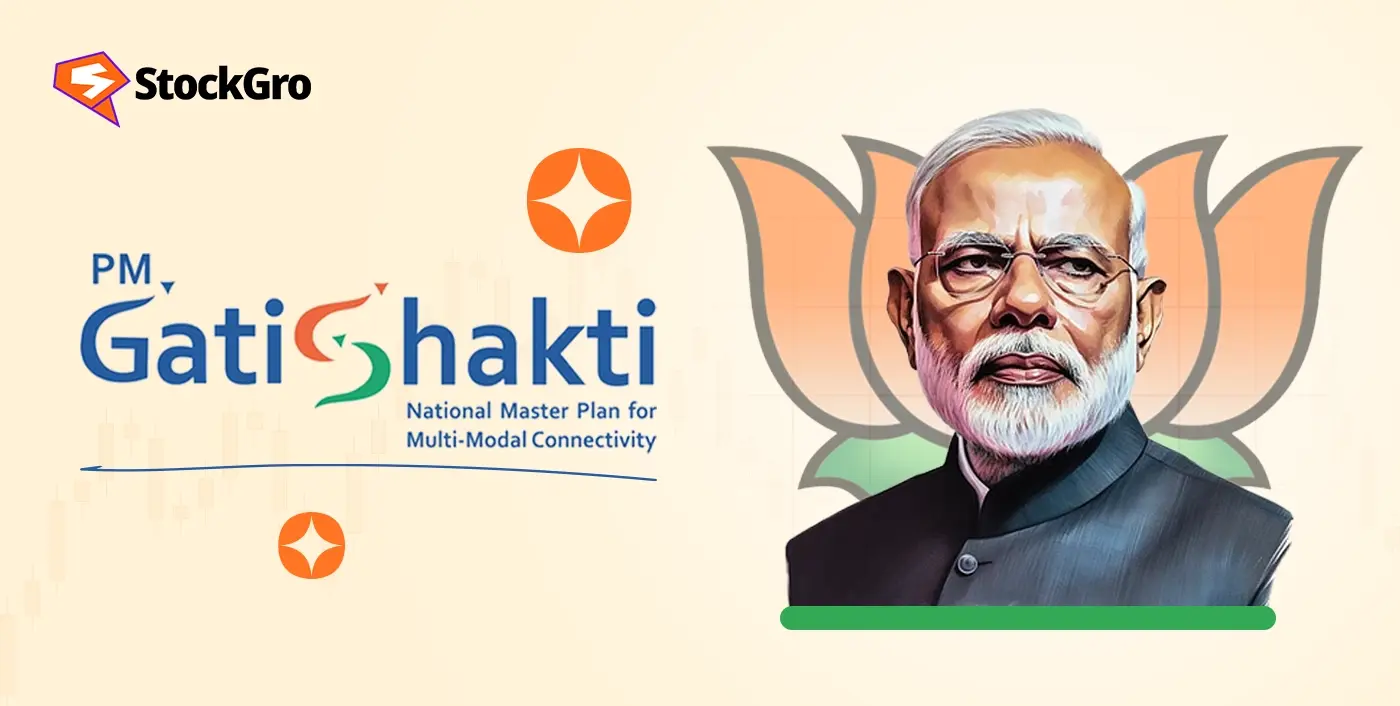
Infrastructure development is the barometer of the growth of a country. The better and more advanced infrastructure leads to higher economic growth. Recognising the gaps in infrastructure, the government introduced the PM Gati Shakti Scheme on 13th October 2021, to drive coordinated development.
Since its launch, the scheme has gained significant momentum, and as of 2024, 208 projects worth ₹15.39 lakh crores have been evaluated under the scheme. This blog sheds light on the PM Gati Shakti scheme.
What is the PM Gati Shakti Yojna?
PM Gati Shakti Yojna (or scheme) is a multimodal connectivity programme, meaning that it will provide a digital platform connecting various ministries and departments for smoother infrastructure project execution and planning with a coordinated effort.
The PM Gati Shakti Scheme seeks to improve information sharing among 16 ministries. This will help make sure projects run smoother, saving time and money. The PM Gati Shakti Scheme has seven engines – roadways, railways, ports, waterways, airports, mass transport, and logistics infrastructure.
The PM Gati Shakti Scheme was launched around six principles:
- Integrated development: To ensure coordinated planning across ministries and departments for seamless infrastructure growth.
- Multimodal infrastructure: Promotes connectivity through multiple transport modes.
- Last mile connectivity: To focus on covering connectivity gaps between main networks and remote or underserved areas.
- Reduced ecological impact: To encourage sustainable development by aligning projects with environmental norms.
- Expedited land acquisition: To speed up infrastructure roll-out by simplifying the land acquisition process.
- Minimised clearances: To reduce delays by integrating and digitising regulatory approvals.
Also Read: Minimum Support Price (MSP) Explained: Meaning, Calculation & Benefits
Objectives of PM Gati Shakti scheme
Here are the main objectives of the PM Gati Shakti scheme:
- Integrated infrastructure planning: Before Gati Shakti, there was poor planning across departments for infrastructure development. For example, a road was built, and later, it was dug up again to install sewage pipelines. This was wasteful expenditure. The scheme aims to curb such wasteful expenditures by improving data sharing and integration among departments.
- Reduce logistics costs: By integrating various modes of transport, it will become cheaper and faster to transport goods. This will ensure connectivity and also lower the time taken for travel.
- Boost economic zones: PM Gati Shakti scheme also aims to connect various economic zones like fishing corridors, pharmaceutical clusters, agriculture zones, etc, to increase the competitiveness of Indian businesses.
Pillars of PM Gati Shakti scheme
The PM Gati Shakti scheme has six pillars:
- Comprehensiveness: This includes all planned and existing initiatives and programmes of all departments and ministries under a single centralised portal. All departments will have data and the latest updates of workings of each other for execution in a comprehensive manner.
- Prioritisation: Based on mutual dependencies and cooperation across sectors, various projects can be given priority. For example, a highway project can be fast-tracked near a key port zone to allow better freight movement.
- Optimisation: Using spatial imaging tools, ministries can optimise locations and alignments of projects. This helps in planning the best routes for fast and cheap transport and identification of critical gaps.
- Synchronisation: Often, there is a lack of coordination between different ministries. This can lead to major delays and errors in project implementations. A national portal will help in better coordination between departments to avoid such inefficiencies.
- Analytical: With its Geospatial Information System (GIS) based spatial planning and analytical tool (with over 200 layers), this plan will provide data in one place. This can provide enhanced visibility for the execution agency.
- Dynamic: The GIS platform will enable all departments and ministries to monitor, review and visualise the progress made by projects with multi-sector involvement. Periodic satellite imagery will provide updates on on-the-ground progress. The portal will have regular progress updates about the projects.
An interesting read: 37 Financial Mistakes to Watch Out For
Benefits of PM Gati Shakti Scheme
Here are some key benefits of the PM Gati Shakti Yojna:
- Enhanced efficiency: The scheme integrates 16 ministries to ensure coordinated planning and faster execution of projects. This will lead to few cost overruns and increased cost and time savings. It will also help various departments prioritise various projects to ensure that the work of other departments is not hindered due to a single department.
- Economic growth: A more integrated infrastructure will help businesses expand. They will be able to export and produce more. The initiative is projected to improve job creation and lead to greater economic expansion. This can also attract foreign investors.
- Ease of doing business: With the help of smoother logistics and transportation, ease of doing business will rise. The scheme has the potential to streamline supply chains, decrease the demand for warehousing, and accelerate delivery schedules.
- Faster project implementation: The Gati Shakti platform, with the help of the latest technologies like GIS and data analytics, can reduce the inefficiencies of various projects. For example, with the help of the Gati Shakti portal, the NoC permissions required for a 300km coastal project in Gujarat were reduced from 28 to 13.
Challenges faced by PM Gati Shakti Scheme
Let us look at some major challenges faced by PM Gati Shakti Yojna:
- Investment: Adopting geospatial technology and creating digital planning and integration tools will require substantial investment periodically. It will also require a skilled workforce. The skill gap can be filled through upskilling and training.
- Land ownership disputes: Land ownership disputes between the government and the public can lead to certain delays in implementation. Additionally, any dispute between various government departments can also cause delays.
- Lack of proper digitisation: While the platform can be technologically advanced, improper documentation at the state or local government level can lead to issues. The absence of digital land records can also hamper decision-making.
Also read: List of Top Logistics Stocks in India 2025
Conclusion
The PM Gati Shakti can be a monumental shift in how Indian infrastructure projects are executed. By uniting different ministries in a single platform it creates a collaborative approach. The tech enabled platform will also help in monitoring the projects. This initiative allows the government to focus on and streamline its most important projects.
FAQs
Gati Shakti aims to integrate various modes of transport like railways, roadways, etc. This will help in the movement of people and goods from one place to the other more efficiently. Gati Shakti will promote infrastructure development that will connect various modes of transport. PM Gati Shakti will also help in better route planning to save time and money on logistics.
The National Master Plan, a GIS-based digital platform, integrates all existing and planned infrastructure projects across various sectors. By providing ministries and departments with access to real-time data. It facilitates better coordination, minimises overlaps and delays, streamlines project implementation, and accelerates project delivery.
Leveraging GIS and satellite imagery, the PM Gati Shakti scheme employs a robust digital framework for infrastructure mapping and progress monitoring. Advanced data analytics plays a crucial role in identifying optimal routes, forecasting potential delays, and providing real-time updates. This digital foundation enhances the precision and responsiveness of infrastructure planning.
By efficiently linking economic centres with robust infrastructure, Gati Shakti establishes a foundation for economic expansion. Improved logistics, lower expenses, and seamless transit of goods and individuals enhance efficiency and draw in investments. This emphasis on infrastructure is crucial for realising India’s goal of a $5 trillion economy.
For effective monitoring and adaptation of the PM Gati Shakti master plan, an Empowered Group of Secretaries (EGoS), chaired by the Cabinet Secretary, has been formed. This group will also evaluate necessary interventions to efficiently transport bulk goods according to the demands of different ministries.

